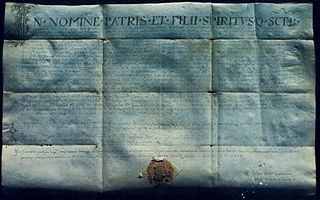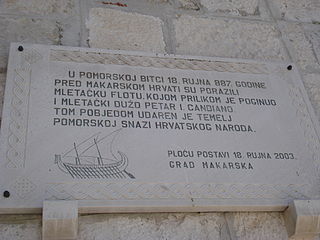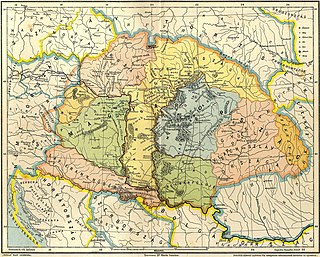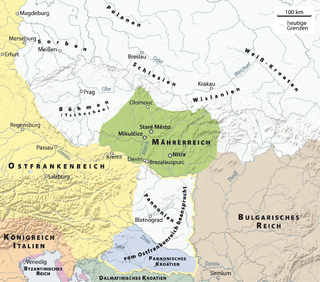 W
WThe Branimir inscription is the oldest preserved monument containing an inscription defining a Croatian medieval ruler as a duke of Croats – Dux Cruatorum. The inscription was originally a part of templon of a church in Šopot at Benkovac built by Duke Branimir, who ruled Croatia from 879–892.
 W
WCharter of Duke Trpimir, also known as Trpimir's deed of donation is the oldest preserved document of the Croatian law, the oldest from the court of one of the Croatian rulers and the first national document which mentions the Croatian name. Charter, dated to 4 March 852, is not preserved in its original form but in five subsequent transcripts out of which the oldest is from year 1568.
 W
WThe Croatian–Bulgarian Wars were a series of conflicts that erupted three times during the 9th and 10th centuries between the medieval realms of Croatia and Bulgaria. During these wars, Croatia formed alliances with Eastern Francia and Byzantium against the Bulgarian Empire.
 W
WThe Croatian–Venetian wars were a series of periodical, punctuated medieval conflicts and naval campaigns waged for control of the northeastern coast of the Adriatic Sea between the City-state of Venice and the Principality of Croatia, at times allied with neighbouring territories – the Principality of the Narentines and Zahumlje in the south and Istrian peninsula in the north. First struggles occurred at the very beginning of the existence of two conflict parties, they intensified in the 9th century, lessened during the 10th century, but intensified again since the beginning of the 11th century.
 W
WSaint Donatus, also called Donato of Zara, was a Dalmatian saint who became a bishop and a diplomat for the Dalmatian city-state of Zadar (Zara). His feast day is celebrated on 25 February.
 W
WThe Duchy of Pannonian Croatia is a name used in Croatian historiography for a medieval Slavic duchy from the 7th to the 10th century located in the Pannonian Plain approximately between the rivers Drava and Sava in today's Croatia. At times, the duchy extended considerably to the south of the Sava, encompassing most of its basin. The modern regions it encompassed include Slavonia, Moslavina, Banovina, Bilogora and Podravina. Its political center was in Sisak.
 W
WThe Guduscani or Guduscans were a tribe around present day Gacka (Lika), between upper Kupa river and the Dalmatian coast, or the inhabitants around the river Guduča near Zadar, a Croatian tribe, i.e. the people of the Bribir region. It has been assumed, that they were part of the Vandals, Goths or Croats. However, the view that the Guduscans were Goths is not widely accepted, their state was in Italy and it ceased to exist in the 6th century, while their presence in the former Roman province of Dalmatia was not dominant. The German historian Josef Baptist von Weiß (1820–1899) thought that the Guduscani were descendants of the East Germanic Vandals.
 W
WThe Croatian interlace or Croatian wattle, known as the pleter or troplet in Croatian, is a type of interlace, most characteristic for its three-ribbon pattern. It is one of the most often used patterns of pre-romanesque Croatian art. It is found on and within churches as well as monasteries built in early medieval Kingdom of Croatia between the 9th and beginning of the 12th century. The ornamental strings were sometimes grouped together with animal and herbal figures.
 W
WLjudevit or Liudewit, was the Duke of Pannonian Croatia from 810 to 823. The capital of his realm was in Sisak. As the ruler of the Pannonian Slavs, he led a resistance to Frankish domination. Having lost the war against Franks, he fled to Ljudemisl, Borna's uncle, who treacherously killed him.
 W
WLower Pannonia was an early medieval region, located in the eastern and southern parts of the former Roman province of Pannonia. Division of Pannonia in two main parts was inherited from the Roman terminology, and during the 9th century, the term Lower Pannonia was used to designate those Pannonian regions that were lying from the river Rába to the east and south. From the middle of the 6th to the end of the 8th century, the region was under the domination of Avars, and also inhabited by Slavs, who were under Avarian rule. By the beginning of the 9th century, Avarian state was destroyed and replaced by the supreme rule of the Frankish Empire, which lasted until Magyar conquest.
 W
WThe Eastern March or March of Pannonia was a frontier march of the Carolingian Empire, named after the former Roman province of Pannonia. It was erected in the mid-ninth century in the lands of the former Avar Khaganate against the threat of Great Moravia and lasted only as long as the strength of that state. It was referred to in some documents as terminum regni Baioariorum in Oriente or "the end of the kingdom of the Bavarians in the east" and from this is sometimes called the "(Bavarian) eastern march," a term more commonly used to refer to the later Margraviate of Austria, established in 976 as a sort of late successor state. The East Frankish rulers appointed margraves (prefects) to govern the March.
 W
WThe Principality of Lower Pannonia, also known as the Balaton Principality, was an early medieval Slavic polity, situated in Lower Pannonia, with capital in Blatnograd. The polity was a vassal principality of the Frankish Empire, or according to others, a frontier county of the Eastern Frankish Kingdom. It was initially led by a dux (Pribina) and later by a comes (Kocel, Pribina's son, who was titled as "Count of the Slavs" .. It was one of the early Slavic polities, that emerged during the early medieval period. It was centered in western regions of modern Hungary, but also included some parts of modern Austria, Slovenia, Croatia and Serbia.
 W
WRatimir was a Croatian duke or prince (knez) that ruled the Duchy of Pannonian Croatia between ca. 829 to 838. His name contents the word "rat", meaning "war", and "mir", meaning "peace". It is believed that Ratimir descends from a royal dynasty that provided rulers for Moravia and Croatia.